|
|
|
Sort Order |
|
|
|
Items / Page
|
|
|
|
|
|
|
| Srl | Item |
| 1 |
ID:
178205
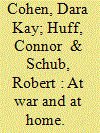

|
|
|
|
|
| Summary/Abstract |
What are the consequences of women dying in combat? We study how women fighting on the frontlines of the military affects public attitudes toward (1) military conflict and (2) women’s equality. We demonstrate through a series of survey experiments that women dying in combat does not reduce public support for war. However, women’s combat deaths do shape perceptions of women’s equality. Women dying in combat increases support for gender equality, particularly in the public sphere of work and politics, but only among women respondents. The findings indicate that women’s combat deaths do not undermine leaders’ ability to garner support for war, but combat service—and indeed, combat sacrifice—alone is insufficient to yield women’s “first-class citizenship” among the general US public. The results highlight how major policy changes challenging traditional conceptions of gender and war can generate positive attitudinal shifts concentrated among members of the underrepresented community.
|
|
|
|
|
|
|
|
|
|
|
|
|
|
|
|
| 2 |
ID:
080680
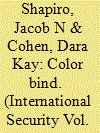

|
|
|
|
|
| Publication |
2007.
|
| Summary/Abstract |
An effective terrorism alert system in a federal government has one central task: to motivate actors to take costly protective measures. The United States' color-coded Homeland Security Advisory System (HSAS) failed in this mission. In federal systems, national leaders cannot compel protective actions by setting an alert level; they must convince constituent governments and private parties that the desired actions are worth the costs. Such beliefs can be generated either by sharing the information behind an alert or by developing enough confidence in the alert system that the government's word alone suffices. The HSAS did neither, largely because it was not designed to generate confidence. Rather, the system's creators assumed that the public would trust the national leadership and believe in the utility of the system's information. Over time, as the HSAS became increasingly perceived as politically manipulated, there was no built-in mechanism to recover confidence in the system. An alternative, trust-based terrorist alert system could solve this problem. Building on the notion of "procedural fairness" from the psychological and legal traditions, this system would retain the political advantages of the HSAS, facilitate greater compliance among the requisite actors, and ameliorate many of the strategic problems inherent in terror alert systems.
|
|
|
|
|
|
|
|
|
|
|
|
|
|
|
|
| 3 |
ID:
141184
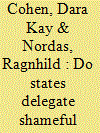

|
|
|
|
|
| Summary/Abstract |
Existing research maintains that governments delegate extreme, gratuitous, or excessively brutal violence to militias. However, analyzing all militias in armed conflicts from 1989 to 2009, we find that this argument does not account for the observed patterns of sexual violence, a form of violence that should be especially likely to be delegated by governments. Instead, we find that states commit sexual violence as a complement to—rather than a substitute for—violence perpetrated by militias. Rather than the logic of delegation, we argue that two characteristics of militia groups increase the probability of perpetrating sexual violence. First, we find that militias that have recruited children are associated with higher levels of sexual violence. This lends support to a socialization hypothesis, in which sexual violence may be used as a tool for building group cohesion. Second, we find that militias that were trained by states are associated with higher levels of sexual violence, which provides evidence for sexual violence as a “practice” of armed groups. These two complementary results suggest that militia-perpetrated sexual violence follows a different logic and is neither the result of delegation nor, perhaps, indiscipline.
|
|
|
|
|
|
|
|
|
|
|
|
|
|
|
|
| 4 |
ID:
186191
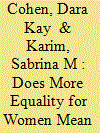

|
|
|
|
|
| Summary/Abstract |
Recent world events, such as the rise of hypermasculine authoritarian leaders, have shown the importance of both sex and gender for understanding international politics. However, quantitative researchers of conflict have long relegated the study of sex and gender inequality as a cause of war to a specialized group of scholars, despite overwhelming evidence that the connections are profound and consequential. In this review essay, we demonstrate the tremendous progress made in this field by analyzing a wave of research that examines the relationships between sex and gender inequality and war. We divide this work into theories that emphasize strategy versus those that analyze structures. In addition, we focus on two aspects of this research agenda—specifying mechanisms that link sex and gender inequality to war, and leveraging data at multiple levels of analysis—to outline fruitful pathways forward for the broader international security research agenda. Ultimately, we argue that the study of the nexus of sex and gender inequality and war will enliven theoretical debates, illuminate new hypotheses, and enrich the policy discourse with robust evidence.
|
|
|
|
|
|
|
|
|
|
|
|
|
|
|
|
| 5 |
ID:
113939


|
|
|
|
|
| Publication |
2012.
|
| Summary/Abstract |
Transnational advocacy organizations are influential actors in the international politics of human rights. While political scientists have described several methods these groups use - particularly a set of strategies termed 'information politics' - scholars have yet to consider the effects of these tactics beyond their immediate impact on public awareness, policy agendas or the behavior of state actors. This article investigates the information politics surrounding sexual violence during Liberia's civil war. We show that two frequently-cited 'facts' about rape in Liberia are inaccurate, and consider how this conventional wisdom gained acceptance. Drawing on the Liberian case and findings from sociology and economics, we develop a theoretical framework that treats inaccurate claims as an effect of 'dueling incentives' - the conflict between advocacy organizations' needs for short-term drama and long-term credibility. From this theoretical framework, we generate hypotheses regarding the effects of information politics on (1) short-term changes in funding for human rights advocacy organizations, (2) short-term changes in human rights outcomes, (3) the institutional health of humanitarian and human rights organizations, and (4) long-run outcomes for the ostensible beneficiaries of such organizations. We conclude by outlining a research agenda in this area, emphasizing the importance of empirical research on information politics in the human rights realm, and particularly its effects on the lives of aid recipients.
|
|
|
|
|
|
|
|
|
|
|
|
|
|
|
|
| 6 |
ID:
127791
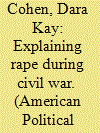

|
|
|
|
|
| Publication |
2014.
|
| Summary/Abstract |
Why do some armed groups commit massive wartime rape, whereas others never do? Using an original dataset, I describe the substantial variation in rape by armed actors during recent civil wars and test a series of competing causal explanations. I find evidence that the recruitment mechanism is associated with the occurrence of wartime rape. Specifically, the findings support an argument about wartime rape as a method of socialization, in which armed groups that recruit by force-through abduction or pressganging-use rape to create unit cohesion. State weakness and insurgent contraband funding are also associated with increased wartime rape by rebel groups. I examine observable implications of the argument in a brief case study of the Sierra Leone civil war. The results challenge common explanations for wartime rape, with important implications for scholars and policy makers.
|
|
|
|
|
|
|
|
|
|
|
|
|
|
|
|
| 7 |
ID:
121906
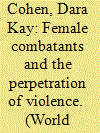

|
|
|
|
|
| Publication |
2013.
|
| Summary/Abstract |
Much of the current scholarship on wartime violence, including studies of the combatants themselves, assumes that women are victims and men are perpetrators. However, there is an increasing awareness that women in armed groups may be active fighters who function as more than just cooks, cleaners, and sexual slaves. In this article, the author focuses on the involvement of female fighters in a form of violence that is commonly thought to be perpetrated only by men: the wartime rape of noncombatants. Using original interviews with ex-combatants and newly available survey data, she finds that in the Sierra Leone civil war, female combatants were participants in the widespread conflict-related violence, including gang rape. A growing body of evidence from other conflicts suggests that Sierra Leone is not an anomaly and that women likely engage in conflict-related violence, including sexual violence, more often than is currently believed. Many standard interpretations of wartime rape are undermined by the participation of female perpetrators. To explain the involvement of women in wartime rape, the author argues that women in armed group units face similar pressure to that faced by their male counterparts to participate in gang rape. The study has broad implications for future avenues of research on wartime violence, as well as for policy.
|
|
|
|
|
|
|
|
|
|
|
|
|
|
|
|
| 8 |
ID:
132356
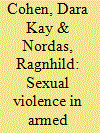

|
|
|
|
|
| Publication |
2014.
|
| Summary/Abstract |
Which armed groups have perpetrated sexual violence in recent conflicts? This article presents patterns from the new Sexual Violence in Armed Conflict (SVAC) dataset. The dataset, coded from the three most widely used sources in the quantitative human rights literature, covers 129 active conflicts, and the 625 armed actors involved in these conflicts, during the period 1989-2009. The unit of observation is the conflict-actor-year, allowing for detailed analysis of the patterns of perpetration of sexual violence for each conflict actor. The dataset captures six dimensions of sexual violence: prevalence, perpetrators, victims, forms, location, and timing. In addition to active conflict-years, the dataset also includes reports of sexual violence committed by conflict actors in the five years post-conflict. We use the data to trace variation in reported conflict-related sexual violence over time, space, and actor type, and outline the dataset's potential utility for scholars. Among the insights offered are that the prevalence of sexual violence varies dramatically by perpetrator group, suggesting that sexual violations are common - but not ubiquitous. In addition, we find that state militaries are more likely to be reported as perpetrators of sexual violence than either rebel groups or militias. Finally, reports of sexual violence continue into the post-conflict period, sometimes at very high levels. The data may be helpful both to scholars and policymakers for better understanding the patterns of sexual violence, its causes, and its consequences.
|
|
|
|
|
|
|
|
|
|
|
|
|
|
|
|
| 9 |
ID:
155202


|
|
|
|
|
| Summary/Abstract |
How do armed groups use violence to create social ties? What are the conditions under which such violence takes place? In this article, I describe how armed groups use one type of atrocity, wartime rape, to create social bonds between fighters through a process of combatant socialization. As a form of stigmatizing, public, and sexualized violence, gang rape is an effective method to communicate norms of masculinity, virility, brutality, and loyalty between fighters. Drawing on literature about socialization processes, I derive a set of hypotheses about individual-level factors that may influence vulnerability to violent socialization, including age, previous socialization experiences, and physical security. I analyze the support for these hypotheses using newly available survey data from former fighters in the Democratic Republic of the Congo. The results show the broad applicability of considering group violence as a form of social control within armed groups, suggest some of the limits of violent socialization, and have implications for both theory and policy.
|
|
|
|
|
|
|
|
|
|
|
|
|
|
|
|
| 10 |
ID:
181083
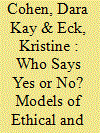

|
|
|
|
|
| Summary/Abstract |
The ethical risks inherent in student research on political violence that involve human participants are myriad. Undergraduate and master’s students face constraints that are different than those for many doctoral students and faculty researchers, and it is the responsibility of educators and academic institutions to ensure that students engage in ethical practices and to mitigate risks. This article focuses on formal mechanisms of oversight. Drawing on discussions with colleagues across the globe, we describe how institutions can design oversight mechanisms to manage student research. We present five distinct models for how ethical oversight of student research is provided in academic programs around the world, considering the costs and benefits of each model. The article concludes that whereas the creation of oversight systems can seem daunting, it is useful to start small—indeed, moving from no oversight to some oversight is a significant improvement. Programs and academic units then can build on these early efforts, experiment with other systems, and eventually develop a system that is adapted to an institution through iterative improvements based on student and faculty experiences.
|
|
|
|
|
|
|
|
|
|
|
|
|
|
|
|
|
|
|
|
|